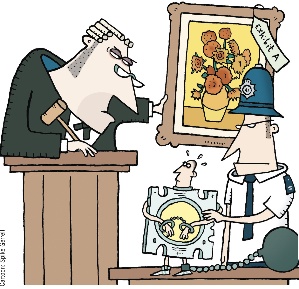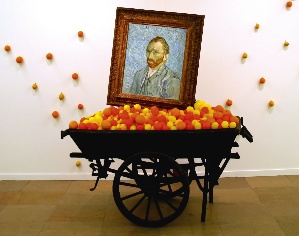
The accused: Scientists in the study didn't actually use LEDs. (Cartoon: Spike Gerrell)
A misunderstanding had the art world believing LEDs were guilty of degrading masterpieces. However, the accusations were unfounded, Angeline Albert discovers
It might have seemed like a fair cop at the time but, in the case of the disappearing Van Goghs, it seems LEDs may have been framed. Experts say recent press reports suggesting LEDs were damaging the yellow pigmentation of works by Van Gogh and other 19th- and 20th-century painters were wide of the mark.
It all started with a press release from the University of Antwerp, which featured a misleading title indicating LEDs may be bad for Van Gogh paintings. It incorrectly summarised findings of a study by a group of researchers from Italy, Belgium, the Netherlands, France and Germany, who investigated changes in the colour of yellow lead chromate pigments used by Van Gogh, Cézanne and other artists. Some UK publications picked up on the press release and repeated its claims that bright-yellow pigment in several famous artworks becomes unstable under LED lights and, over time, turns a shade of brownish green.
However, it now transpires the scientists in the study didn't actually use LEDs; in fact, a high-intensity Xenon lamp (Cermax 175W) was used in combination with different wavelength filters. A co-author of the study, Professor Brunetto Brunetti, who works at the University of Perugia's department of chemistry, told Lighting: "We did not experiment using LED lights. We are going to carry out some tests in the future in collaboration with some manufacturers, to see the impact of LEDs."
Erroneous reports
LED lamp manufacturer Soraa has publicly responded to what it describes as "erroneous reports of painting degradation by LED lamps" stating that the findings had been "loosely and irresponsibly associated with LED lighting." It said the Xenon lamp used in the study has a spectrum that is "vastly different from those of white-emitting LEDs for illumination, with the Xenon lamp including significant amounts of ultraviolet (UV) light in the UV-A, UV-B, and UV-C wavelength regimes."
Degradation of the paint samples was observed under intense irradiation, said Soraa, amounting to "more than 1,000 times the values used in conventional illumination when the Xenon lamp was used in conjunction with a so-called blue filter, passing wavelengths between 335 nanometres (UV-A) and 525 nanometres (green), which is in fact about five times broader than the blue wavelength regime." In a press statement, it said: "It is very plausible that the degradation observed by the researchers at the University of Antwerp is caused by UV-A light leaking through the 'blue filter' they employed."
Energy audit
The slow pace at which LEDs are being accepted by the museum sector could be quickened by the light source's energy-efficiency credentials. For the first time, major museums funded by Arts Council England will report on their carbon emissions. Maurice Davies, head of policy and communications at the Museums Association, says a carbon audit of the sector has never been carried out in the UK. He says: "My hunch is that, apart from visitor travel to and from the museum, lighting makes up a significant part of the footprint". Perhaps LEDs will be seen with a fresh pair of eyes when the audit results are reported.
Paul Ruffles, chair of technical and publications committee at the Society of Light and Lighting (SLL) can understand why the press coverage caused such a fuss and why Soraa was moved to issue a statement: "With the current generation of LEDs there?is no UV output. That is why the coverage about the survey was such a thorn in the side for LED use."
False conclusions
In response to reports on the Van Gogh research, Darmstadt University has written a study of its own by Peter Bodrogi. It says: "Several recent articles drew the false conclusion that, according to their supposedly large blue and UV content, white LED light sources would damage these paintings and the usage of white LEDs should be avoided in museums." It adds that "commercially available white LEDs are less dangerous in museums for the aging of yellow painting pigments than other light sources, including fluorescent lamps and daylight."
When Lighting approached Maurice Davies, head of policy and communications at the Museums Association (MA), about the story he suggested inaccurate press reports were not helpful for a sector in which 'urban legends' were common. MA has a membership of 600 museum organisations, representing 1,000 sites in the UK. Davies says: "Lighting designers need to be aware that the understanding of lighting by the museum industry is much less than designers hope it would be." Although he points out this is not the case with large-scale museums. "The average museum does not even employ a conservator on the books. Education is needed," he said.

Framed: The press mistakenly reported that LEDs would turn the bright-yellow pigment used in works by Van Gough a shade of brownish green
"We did not experiment using LED lights. We are going to carry out some tests in the future in collaboration with some manufacturers, to see the impact of LEDs"
Professor Brunetto Brunetti, University of Perugia's department of chemistry
Davies believes museums, many of which rely on lottery funding to kick-start projects, "are working to a very slow timescale – maybe five years from start to finish – while development in lighting technology is moving fast".
Ruffles admits that even the "long-overdue" revision of the SLL's LG8 guidelines, Lighting for Museums and Art Galleries,?(last updated in 1994), expected to be published this summer, refuses to recommend specific lamp types "because of the rapidly developing nature of lighting technologies". But it is safe to assume art degradation will be a central focus of the new guidelines.
When it comes to lighting art, as Ruffles says, the degradation debate is a "visibility versus damage" conundrum. "If you can see the art, you are damaging it." He says what it comes down to is this: "How do you measure damage? How much exposure to light does a particular material have and how much degradation is acceptable?"
A hidden benefit
Degradation due to ultraviolet exposure is one thing but Paul Ruffles, chair of the technical and publications committee at the Society of Light and Lighting points to a 'hidden benefit' with LEDs that isn't discussed as much: "With LEDs there is no need to relamp as often and, therefore, no need to get up ladders and add scaffolding to move objects out of the way, which can sometimes cause more harm to the art than good."


